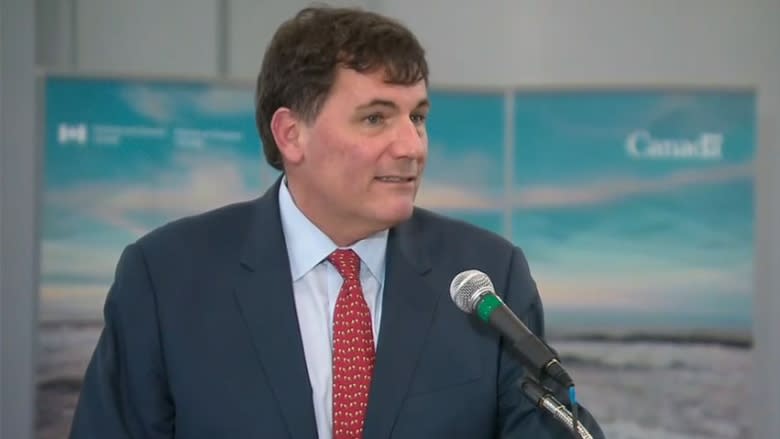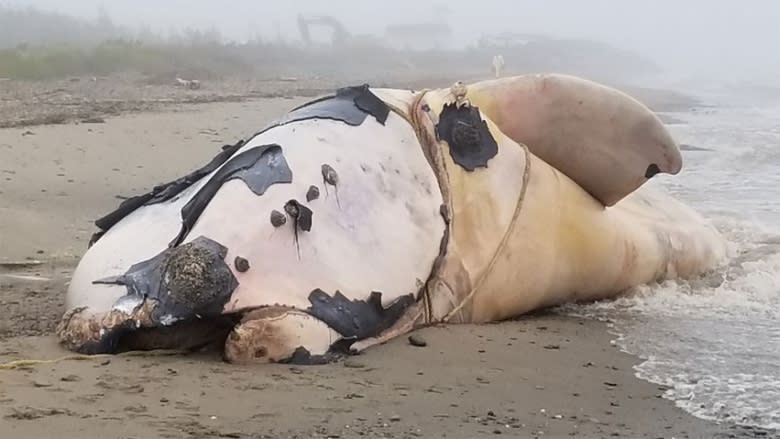New snow crab fishing rules rein in use of ropes to protect North Atlantic right whales
Fisheries and Oceans Minister Dominic LeBlanc has announced four changes to the snow crab fishery in the southern Gulf of St. Lawrence to protect North Atlantic right whales from entanglement, including reducing the amount of rope floating on the surface and mandatory reporting of all lost gear.
The new management measures will take effect immediately and will be enforced "very aggressively," LeBlanc said during the news conference in Moncton on Tuesday.
A "series" of other measures will be announced in the coming weeks and months, said LeBlanc, but he wanted to announce these steps now to allow the industry time to prepare for the upcoming season, which normally begins around mid-April, depending on the amount of ice.
The government will "most likely" impose speed restrictions for vessels again, LeBlanc told reporters, but the primary responsibility for that belongs to Transport Canada Minister Marc Garneau, he said.
Last summer, Transport Canada imposed a mandatory 10-knot speed limit in the western part of the Gulf of St. Lawrence for vessels 20 metres or longer to help reduce the risk of whale strikes and to improve the chances of survival for any whales struck.
Other pending crab fishery measures will relate to the number of traps permitted this season and the possibility of using Coast Guard ice-breakers to start the season sooner, said LeBlanc.
That would allow fishermen to catch their quota and remove their gear from the water as early as possible, "hopefully reducing the risk of contact with the whales."
Scientists have advised the government North Atlantic right whales could be back in the gulf as early as April, Transport Canada communications adviser Julie Leroux said.
It is not possible to predict how many will return, said Leroux, "due to the variability" observed in recent years.
The government will also invest "many millions of dollars" in "very high-tech, state-of-the-art detection and monitoring equipment" that will help protect North Atlantic right whales on the East Coast and killer whales on the west coast, said LeBlanc.
At least 17 North Atlantic right whales died in Canadian and U.S. waters last year.
Necropsies on seven of the carcasses determined four whales died of blunt force trauma from collisions with ships, while the other three likely died from entanglements in fishing gear.
'Extremely dire'
There are only an estimated 450 to 500 of the whales left in the world.
Of those, only about 100 are breeding females, said Kim Davies, an oceanographer at Dalhousie University and an expert on North Atlantic right whales.
The situation is "extremely dire," she said.
Any measures that help to reduce the amount of fishing line in the water, especially slack line on the surface, "is a very good step," said Davies.
Right whales tend to spend a lot of time at the surface — coming up to breathe, feed and socialize, she said. "So this slack line really represents a high entanglement risk."
The normal life expectancy of the animals is about 70 years, "but we kill them [through fishing gear entanglements and collisions with vessels] by the ages of 20 to 30."
Based on the current rates of mortality and populations growth, researchers expect all of the breeding females will be dead within two decades, said Davies.
"So every whale counts. Every whale that we can stop from becoming entangled counts toward saving the population."
An unprecedented number of the right whales appeared in the gulf last year, which scientists suspect is related to climate change forcing the whales to find new sources of food.
Colour-coded ropes, numbered buoys
Under the new crab fishing rules, a maximum of 3.7 metres (two fathoms) of rope can be used when attaching a secondary buoy to a primary buoy, said LeBlanc.
Previously, there has been no restriction on the amount of rope used, he said, noting the government heard about "dozens of metres" of rope being used in some cases.
Fishermen will also be required to add metal weights to portions of the rope that attaches a crab trap to a primary buoy to ensure the rope is vertical and not floating on the surface of the water once the crab trap has been set.
That rope will now be marked with the colour specific to the fishing area in which they're authorized to fish, which will help officials identify the place of origin of any future entanglements, said LeBlanc.
Research has shown entangled whales can travel "hundreds of kilometres" away from the area where they first came into contact with the fishing gear, he said.
Similarly, each buoy will be marked with a sequential number to identify where it came from and lost gear must be reported, along with its last-known GPS position.
This will help the government understand how much fishing gear is lost annually and determine if it needs to assist with retrieval efforts, said LeBlanc.
'Rigorous' inspections
Conservation protection officers will be inspecting gear "rigorously" on wharves and at sea before and during the season, said LeBlanc.
"We're expecting 100 per cent compliance," he said, pointing out some of the new measures were suggested by the industry itself.
"They have shown an enormous desire to collaborate with us," said LeBlanc. "So I don't imagine there will be much tolerance from the fishing industry for members … who choose not to respect these conditions."
Anyone who doesn't "will face the consequences."
The new requirements will be included in a harvester's licence conditions, department spokesperson Krista Petersen later told CBC News.
"A person found by a fishery officer to be in contravention of the regulations may be charged with an offence that can result in punishment ranging from fines to an indictable offence," she said.
The minister said it will be up to prosecutors and judges to determine the penalties, in accordance with the Fisheries Act.
"But I am saying publicly that we will regard these as serious offences and our investigating officers will be treating these are serious offences and will be working with prosecutors and others to ensure the seriousness of these offences is understood."
To help fishermen transition to the new requirements, conservation protection officers will be available immediately to answer questions, LeBlanc said.
No decision yet on rescues
Whale rescues, suspended last summer after Campobello Island fisherman Joe Howlett was killed trying to free an entangled whale, remain on hold for now, said LeBlanc.
But he hopes to announce a "Plan B" before the whales return.
"Until I'm satisfied that we have a safe operational plan, I cannot in good conscience allow people's safety to be put in jeopardy, but I'm encouraged … that we'll be able ot arrive at a safe plan," he said.
U.S. fisheries service being sued
In the United States, conservation and animal-protection groups are suing the National Marine Fisheries Service, alleging it failed to protect right whales from entanglement in commercial fishing gear.
The lawsuit alleges the federal management of the U.S. lobster fishery violates the Endangered Species Act and the Marine Mammal Protection Act.
It seeks to force the agency to do a sufficient examination of the fishery's impact on North Atlantic right whales and take more steps to prevent entanglements.



